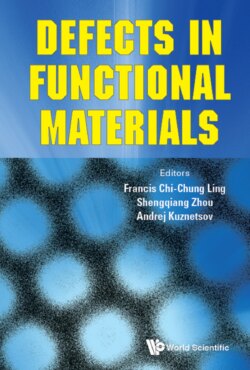Читать книгу Defects in Functional Materials - Группа авторов - Страница 22
3.1.1. Vacancies and antisite defects
ОглавлениеDiverse intrinsic point defects in CVD-grown MoS2 were first systematically characterized by Zhou et al. [1] by using atomic resolution HAADF imaging. Due to the large intensity difference of Mo and S2 column in this Z-contrast mode, it is easy to directly assign the type of the point defects. Single-site sulfur vacancies were found to be the most common defects, including mono-vacancy (VS) and double-vacancy (VS2) with only one or two S atoms missing from the S sublattice. Other less common defects observed include extended Mo vacancies such as VMoS3 and VMoS6, and antisite defects with Mo atom replacing S2 column (MoS2) or S2 occupying the Mo site (S2Mo), but with a much lower frequency. Through HRTEM imaging, Komsa et al. [18] observed the structure of single vacancies VS and VS2 in monolayer MoS2 with atomic resolution, which could be readily created by electron beam irradiation at an acceleration voltage of 80 kV. Atomic S vacancies get generated and agglomerated in the monolayer under the electron beam irradiation. These vacancy sites could accommodate impurity atoms to form substitutional dopants, such as N, P, As, and Sb in V-A group behaving as acceptors and F, Cl, Br, I in VII-A group as donors, respectively. This electron beammediated substitutional doping could serve as a route to engineer the local electronic structure of TMDs.
Using atomically resolved ADF imaging, Jin et al. found plenty of antisite defects emerging in physical vapor-deposited (PVD) MoS2 monolayers. Figure 2 is an image gallery to demonstrate all types of antisite defects in monolayer MoS2 including Mo replacing S sublattice (MoS, MoS2, Mo2S2) and S substituting Mo sublattice (SMo, S2Mo). In the ADF imaging mode, these two different categories of antisites can be easily distinguished and even quantitatively analyzed. The experimental atomically resolved ADF-STEM images of antisites agree well with the simulated images based on density functional theory (DFT) relaxed structures. The DFT relaxed atomic model of antisite MoS in Fig. 2k still retains the three-fold symmetry, while antisite MoS2 (in Fig. 2l) has an obvious off-center characteristic because of the deviation of the antisite Mo atom from the center of the triangles formed by the three nearest-neighboring Mo atoms. The different structural symmetries between MoS and MoS2 give rise to their contrasting magnetic properties.
